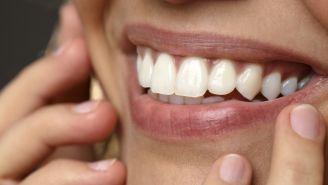Updated on November 7, 2024.
You probably know how important daily oral hygiene is for the strength and health of your teeth and gums. But healthy gums and teeth are also good for your whole body.
Researchers have confirmed a connection between gum disease (also known as periodontal disease) and inflammation—the kind of inflammation that could contribute to heart disease and diabetes. Other research suggests a link between a healthy smile and a lower incidence of certain types of cancer.
If you already have a consistent daily oral health routine, that’s great. Keep up the good work. If your oral care routine could use some help, follow these simple tips to up your game.
Brushing: Remember to go the distance
You should brush your teeth twice a day. And when you do, be sure not to skimp on time.
Most people spend only 45 seconds brushing their teeth. But if you increase your brushing time to 2 minutes, you'll remove 25 percent more plaque. (Plaque is a sticky film of food residue and bacteria that forms naturally on your teeth.)
To make sure you are brushing properly, follow these tips:
Lighten up. Brushing too hard can damage teeth and gums. Use a light touch when you brush, applying no more force than what would amount to the weight of a small apple.
Work the angles. Hold your toothbrush at a 45-degree angle, and use small, circular strokes to gently remove plaque along the gumline of your inner and outer tooth surfaces. To clean chewing surfaces, use back-and-forth strokes. And give your tongue a few swipes, too, to help prevent bad breath.
Refresh your brush. Your toothbrush bristles wear out over time, reducing the amount of plaque that you can easily remove. Replace your brush every 2 to 3 months—or more often if the bristles look worn or frayed.
Flossing: Think 18
Brushing daily is great. But if you don't floss, too, you're leaving 40 percent of your tooth surface untouched. And if you floss but don't use a long enough piece of string, you're just pushing that plaque around your mouth from tooth to tooth.
So start with an 18-inch piece of floss, and move to a fresh bit of string for each new tooth you clean. Hold the floss tightly between your thumbs and index fingers and gently curl the floss around the tooth edge, sliding up and down along the tooth surface. And be sure to go under the gumline.
What you don't want is to make a back-and-forth sawing motion with the string. If you do this, you'll end up cutting your gums and allowing more plaque and bacteria to build up between your teeth.
Scraping: See the pros for regular maintenance
To help keep your teeth in tip-top shape, you should see a dental hygienist twice a year for a round of teeth cleaning. Even if you're a top-notch brusher and flosser, you'll still need professional cleanings to remove tartar buildup. (Tartar is a hardened form of plaque.)
Your hygienist will use a process called scaling to scrape off the tartar and plaque. They will also polish your teeth and remove stains to help prevent future plaque buildup, cavities, and gum disease.
What foods make your teeth happy? Check out these top smile savers and spoilers.







